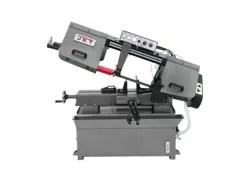Loading ...
Loading ...
Loading ...

15
Feed on/off selector (F) – Turn knob to “I” to open
hydraulic cylinder and allow bow descent; turn to “O”
to hold bow in raised position.
Figure 8-1
9.0 Prior to Operation
Inspect the following before operating the band saw.
1. Check that blade tooth direction matches arrow
on blade guides.
2. Check to see that blade is properly seated on
wheels with correct tension (approximately
25,000 lbs.).
3. Set blade guide brackets as close to work as
possible without obstruction.
4. Check for slight clearance between rear support
bearings and back of blade.
5. Select proper speed and feed rate for material
being cut.
6. Material must be securely clamped in vise.
7. Check to see that cutting fluid/coolant level is
adequate and turn on coolant pump if material
requires it. Machine should be filled with proper
amount of coolant mixture. Follow directions on
coolant manufacturer’s label and fill coolant
tank by pouring through the chip tray.
8. Do not start cut on a sharp edge.
9. Keep machine lubricated. See sect. 11.1.
10.0 Operation
General operating procedure:
1. Turn feed knob to off.
2. Raise bow and set desired feed rate.
3. Position workpiece; make sure it is secure
within vise. Make sure left blade guide bracket
is adjusted as close as possible to left vise jaw
without obstruction.
4. Press Start to begin blade movement. Activate
and adjust coolant flow.
5. Turn feed knob to on. Adjust feed rate further if
needed.
6. Blade will shut off at end of cut. (If blade does
not shut off, limit switch stop bolt needs
adjustment.)
10.1 Blade selection
The HBS-916 and HBS-1018 are provided with a
hook-type variable-tooth blade adequate for a wide
range of jobs on a variety of common materials.
Sect. 12.0 shows recommended speeds for various
materials. These selections, while appropriate for
many shop cutting needs, do not encompass the
wide variety of blades of special configuration (tooth
pitch and set) and special alloys for cutting unusual
or exotic materials.
A coarse blade could be used for a solid steel bar
but a finer tooth blade would be used on a thin-wall
tube. In general, the blade choice is determined by
the thickness of the material; the thinner the
material, the finer the tooth pitch.
A minimum of three teeth should be on the
workpiece at all times for proper cutting. The blade
and workpiece can be damaged if the teeth are so
far apart that they straddle the workpiece.
For very high production on cutting of special
materials, or for hard-to-cut materials such as
stainless steel, tool steel, or titanium, ask your
industrial distributor for more specific blade
recommendations.
Also, the supplier who provides the workpiece
material should be prepared to provide very specific
instructions regarding the best blade (and coolant or
cutting fluid, if needed) for the material and shape
supplied.
10.2 Blade break-in procedure
New blades are very sharp and, therefore, have a
tooth geometry which is easily damaged if a careful
break-in procedure is not followed. Consult the
blade manufacturer’s literature for break-in of
specific blades on specific materials. However, the
following procedure will be adequate for break-in of
JET-supplied blades on lower alloy ferrous
materials.
1. Clamp a round section workpiece in the vise.
The workpiece should be 2 inches or larger in
diameter.
2. Set the saw on low speed. Start the cut with a
very light feed rate.
3. When the saw has completed 1/3 of the cut,
increase the feed rate slightly and allow the saw
to complete the cut.
4. Keep the same feed rate and begin a second
cut on the same or similar workpiece.
Loading ...
Loading ...
Loading ...
